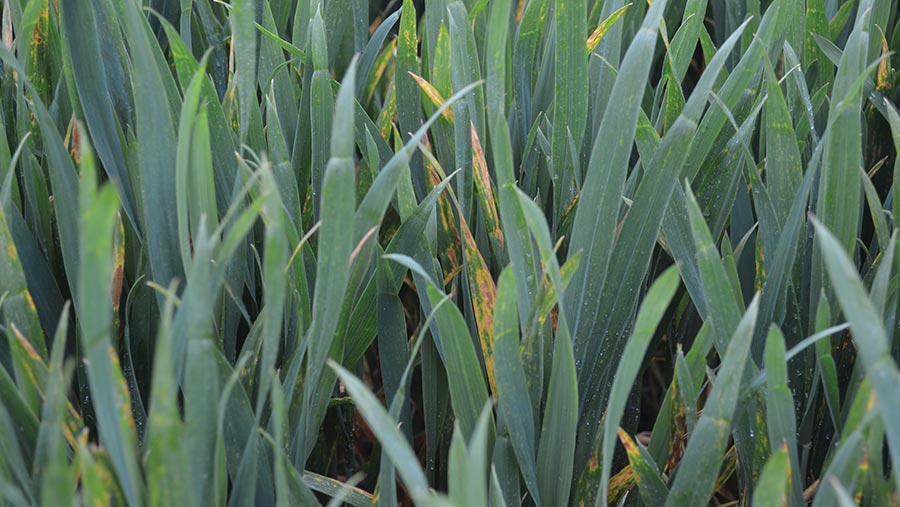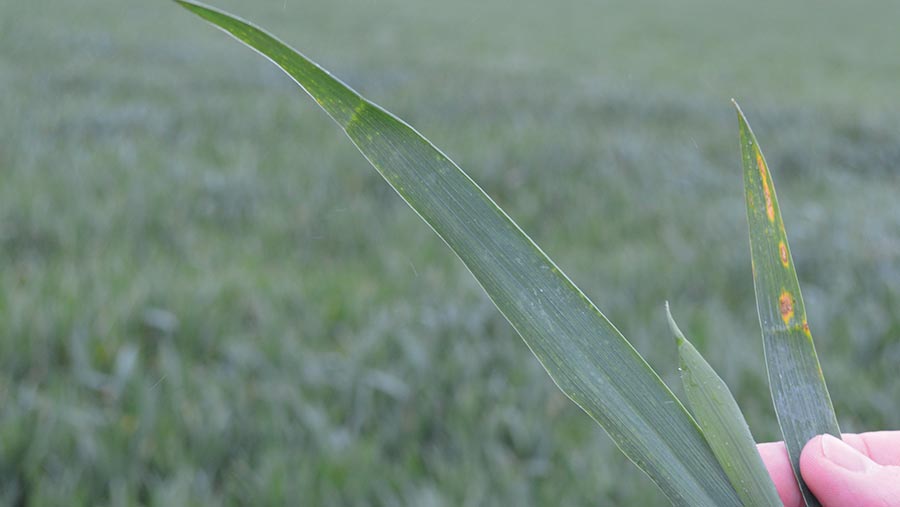Wheat fungicide choices as costs rise in wet septoria season
 © MAG/David Jones
© MAG/David Jones Winter wheat growers are likely to spend up to £30/ha extra or more on fungicides this season due to the very wet May weather, which has created a “perfect storm” for septoria disease to spread rapidly through crops.
Agronomist Peter Riley, based in East Anglia, is budgeting that his arable clients will be spending £120-£170/ha this season or even more, compared with last season’s spend of £100-£140/ha.
“Big crop canopies and unsettled weather in May are the perfect storm for septoria,” he tells Farmers Weekly.
See also: Advice on septoria spread as wheat T1 fungicide timing nears
Best eradicant
This has prompted Peter, who works for agronomy advisory group Farmacy, to chose the material with the best eradicant activity against septoria – the azole mefentrifluconazole – as the base of his T2 flag-leaf sprays.
This relatively new azole is sold in a mixture with the SDHI fluxapyroxad in the product Revystar.
He considers rival fungicide mix Univoq (fenpicoxamid + prothioconazole) as a good product, but it works better in a more protectant situation.
On James Forrest’s Suffolk farm, where Cameron Hale is the main agronomist supported by his colleague Peter, variety trials showed substantial septoria disease on leaf four.
There were also small visible signs on leaf three on susceptible wheat varieties in untreated fungicide plots in May.

Septoria on leaf three © MAG/David Jones
James is growing 330ha of winter wheat on the 1,600ha he farms as RH Forrest & Co at Mowness Hall, near Stonham, just north of Stowmarket.
He says the “investment” in a fungicide programme is needed if yields are not to suffer in a bad disease year.
“We need to maximise output due to BPS being dramatically reduced,” says James.
The BPS area-based subsidy is being reduced between 2020 and 2027 and replaced by payments to benefit the environment under the Environmental Land Management (ELM) scheme.
Wheat yields
His five-year average winter wheat yield on his medium heavy soils is about 10t/ha, and last year he was pleased to see yields of 10.5-11t/ha.
James generally drills most of his wheats between 20 September and early October, with some later drillings after sugar beet.
He grows seed crops of Champion, Extase and Astronomer, with generally good disease resistance against septoria, and also Wolverine which is less good against septoria.
James operates two 40m sprayers on the farm so has adequate capacity on the farm to get round all his wheat in one day, if necessary.
This season, the fungicide programme has seen the yellow rust-active azole tebuconazole used at T0.
“We look to tailor the T1 to drilling date and the resistance of the variety,” says Peter.
With no very early sown wheat and most of the varieties on the farm with good septoria ratings, Peter has gone with Ascra (SDHIs bixafen and fluopyram plus azole prothioconazole) alongside the multisite folpet at the T1 stage.
The T2 is Revystar and folpet because of the high risk of disease.
Revystar is likely to be used at a minimum rate of 1.25 litres/ha, with the recommendation for the product at T2 being 1-1.5 litres/ha.
Peter recommends 15 winter wheat varieties to his clients ranging from Champion with a septoria rating of 8.1 to Skyscraper with a rating of 4.9.
He believes that mid-September drillings ideally need a 6-plus score and mid-October drillings a 5.5-plus, on a 1-9 scale where 1 is very susceptible and 9 shows good resistance.
The risk of disease is very high this season and the response to using fungicides could be as much as 2-4t/ha, whereas in a more normal year it could be only 1.5-2t/ha.
“If we do not spend on fungicides, the yield is going to suffer, so we do not have a lot of choice,” says James.
Open day
James Forrest is holding an open day on 27 June for members of his local co-operative Fram Farmers, in conjunction with agrochemicals group BASF and Walnes Seeds, looking at the cereal variety trials on his farm.

